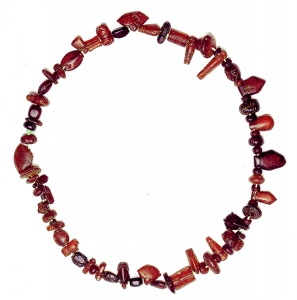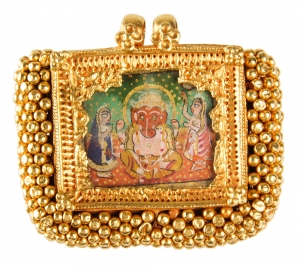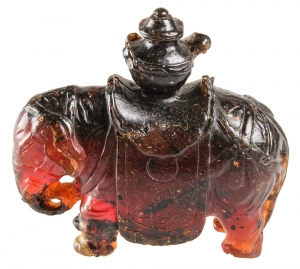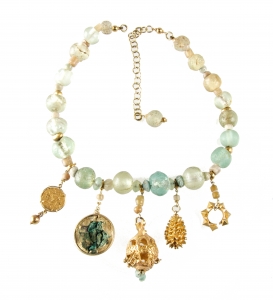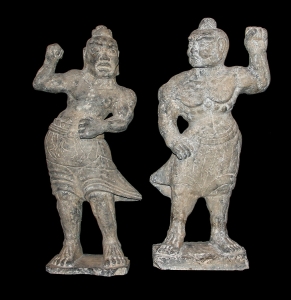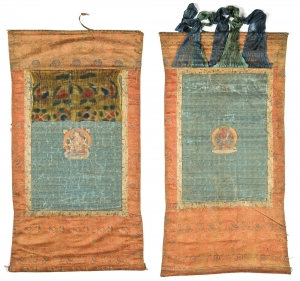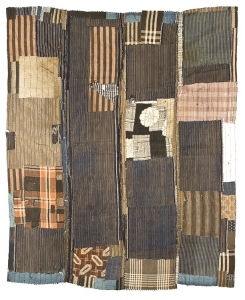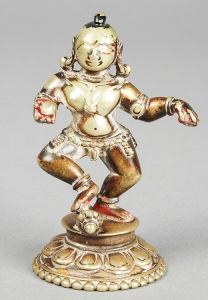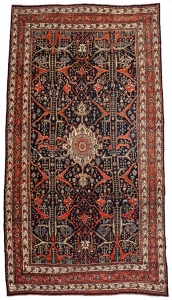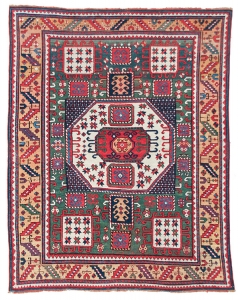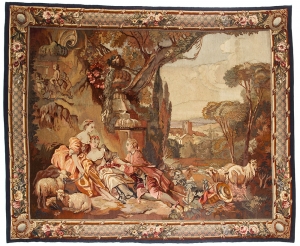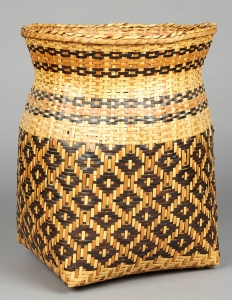Ancient and Traditional Arts
Live Auction: Saturday, October 31, 2015, 10am est
Exhibition: October 29-30, 11am-5pm
Lots 1-178: The Piero and Paola Ferro Collection: Antique Chinese Amber, Jade, Archeo Gold and Talismans
Lots 179-775: Asian, Ethnographic Arts, Antique Oriental Rugs & Textiles
Browse the Auction Catalog and Bid Live on LiveAuctioneers.com
Browse the Auction Catalog and Bid Live on Bidsquare.com
Browse the Virtual Print Catalog
Absentee Bid Form | Telephone Bid Form | Terms and Conditions (PDF)
Material Culture’s upcoming auction, “Ancient and Traditional Arts,” is a sale with such breadth of outstanding art and artifacts that it has been divided into a two-part event. The full day of sales begins at 10 AM, on Saturday, October 31, 2015, opening with the Piero and Paola Ferro collection of antique Chinese amber, jade, archeological gold and talismans. Part two, “Asian, Ethnographic Arts, Antique Oriental Rugs and Textiles,” a wealth of topnotch pieces in these categories, will commence at a time to be determined by the pace of bidding.
The Piero and Paola Ferro Collection (Lots 1-178)
Piero and Paola Ferro, of Milan, Italy, found their artistic calling as jewelry designers and craftspeople, drawing inspiration from antique, original pieces that they collected on their wide-ranging and frequent travels across Asia and the Middle East. Their brand, established in 1986, brings a strong multiethnic imprint to modern design, incorporating found pieces from these journeys in a synthesis of centuries and continents. A dedicated globetrotter, Piero Ferro began buying antiques abroad in 1978, and when he and Paola met in 1982, they began traveling together, seeking out treasures to resell to European dealers as a means of making their passion for travel into a business. Eventually, the precious stones, pearls, artifacts and jewelry fragments they found inspired their own designs, and they began traveling in part to source these incomparable materials. But on all of their trips, they would keep something truly exceptional or captivating for themselves—and this collection, the harvest of their extensive travels, is what Material Culture is proud to bring to market in this sale.
Nearly 300 pieces come to the sale from the Ferro collection, with origins in China, India, Pakistan, Afghanistan, Iran, Yemen, Japan, Thailand, Indonesia and the Philippines, and dating as far back as the second century BCE. One rare piece, preserved in its entirety, which might be said to lead the sale is an extraordinary Seljuq dynasty Iranian necklace made of carved amber amulets, dating to the 11th century. The amulets ringing the necklace bear different shapes—spearheads, lions, sphinx, and anthropomorphic figures—but all are carved in red amber, one of the most rare and valuable varieties. Another complete piece of sequence jewelry, remarkably maintained for its millennia of age, is a striking bracelet which alternates 22-karat gold beads with pieces of amber in different hues. The bracelet likely dates to the Parthian or Arsacid dynasty of the Persian Empire, as old as the 2nd century BCE.
The collection features a trove of ancient and antique gold jewelry from Afghanistan, Persia, India, Indonesia and the Philippines, including rings, bracelets, earrings, pendants, necklaces, and other artifacts. From the Majapahit period of what is now known as Indonesia, a pair of embossed and chiseled 22 karat gold bracelets, dating to the 15th century, are exceptionally fine. A 15th century gold ring evokes the splendor of this era, with a rose-like pattern encircling an apotropaic agate. A number of finely-detailed earrings and delicate ‘bird rings’ in the auction from this Javanese empire may date as far back as the 10th century. A highlight of later Indonesian gold is a stunning 18th century bracelet from Sulawesi, in finely-detailed 14 karat gold.
Some of the auction’s outstanding pieces in gold originate in India. One of the most remarkable is a 19th century pendant, with a painted surface that depicts Ganesha, flanked by Saraswati and Lakshmi. A brilliant, detailed frame of 22 karat gold, with layers of small golden orbs, encompasses the image. A complete necklace from the 19th century centers around another deity pendant, with eight ornaments of paper miniatures encased in glass on either side. Each piece of glass—square, round, and teardrop-shaped—are encased in 22 karat gold, with bell-like gold balls suspended from the bottom. Equally impressive, a string of 22 karat gold beads, with an intricate cut work and granulation construction, also dates to the 19th century.
Another highlight in gold, as old as the 10th century, is a 22 karat star pendant with seven points, from the Philippines. It is auctioned along with the modern 22 karat gold snake chain from which it hangs. From Japan, a brooch of hammered 18 karat gold provides a magnificent mount for a kashira, the ornamented end of a sword’s hilt; this repurposing is a 19th century creation. Another item mounted in gold is a Roman-era jasper seal, fitted into a 20th century ring of 22 karats.
Probably the oldest artifacts at auction from the Ferro collection are its pieces of Bactrian gold, dating to the 2nd century BCE. From what is present-day Afghanistan, a pair of gold and garnet dolphin earrings, and a pendant of two birds holding a pearl, both in 22 karat gold, are most evocative of the Grecian and animist components of this culture. Other pieces of gold originating in the Bactrian kingdom include a 22 karat gold bracelet, two gold and garnet rings, and several pairs of earrings, including an impressively delicate pair of flower earrings with pendant petal-like discs. The auction also includes several ancient Bactrian stone seals, which are likely centuries older.
A substantial and important part of the collection is the abundance of antique Chinese amber, all of which dates to either the Ming Dynasty (1368-1644) or the Qing Dynasty (1644-1912). Perhaps the most impressive piece is an elephant statue made of rare deep red Burmite amber, but each of the amber artifacts in the auction displays a gorgeous marriage of hue and artistry. A total of 37 amber amulets depict a diversity of forms—human, dragon, phoenix, qilin, carp, flower, leaf, waves, clouds—which would have been stitched into cloth caps, made into pins or belt buckles to carry on the person as a talisman. Amber from Burma and from the Roman era are also brought to auction.
No less remarkable is the Ferro collection of jade, from several different cultures. From Moghul India, four separate lots of white jade pendants are exquisitely inlaid with gems and gold in the Islamic motif of different flowers springing from a single root. The most ornate is dotted with emeralds and diamonds, and features an additional crescent moon and calligraphic figure; all date to the 19th century. Also from 19th century India, a spinach jade walking stick handle is capped with the finely carved head of a mouflon ram. Two pieces of excellent Chinese jade incorporate other precious materials: a Qing Dynasty jade pendant is looped by gold and pink sapphires, and a white jade swan of the 19th century has a chiselled wave-capped wreath of 18 karat gold in which to nest. The sale also includes jade from Burma and Japan.
Another thrilling addition to the auction are seven pieces designed and created by Paola Ferro, giving ancient elements a new birth with modern invention. Each possesses a unique spirit through the amalgamation of its pieces’ history—one gorgeous necklace marries Roman translucent glass beads, sourced from Syria for the rich iron in its sand, Bactrian gold amulets from centuries BCE, and two fifteenth-century Arab coins. Another necklaces reunites an assortment of lapis lazuli beads and amulets from the Afghanistan of the Middle Ages, neatly spaced with gold beads. Pendants of Roman glass shaped like birds take flight alongside gold butterflies around a chain of glass beads and gold.
Asian, Ethnographic Arts, Antique Oriental Rugs & Textiles (Lots 179-775)
With nearly 600 lots in the auction’s second half alone, many different categories of art, from a variety of cultures, boast remarkable entries. China’s centuries of exquisite artistic tradition provide some of the sale’s many highlights, led by a pair of Dvarapala carved stone sculptures dating to the Tang Dynasty (618-907 CE). Muscular and fierce, these gate guardians strike an imposing posture, with one arm raised and one akimbo. Their stone is a dark gray, with remnants of white pigment; bases of original stone support the feet, with custom-built additional stands included.
From over a millennia later, but no less exceptional, a rare embroidered silk dragon robe features a multitude of golden dragons on a black field, with a prismatic play of metal thread. During the Qing Dynasty, to which this 19th century robe dates, “dragon robes” became the official name for these garments, which had been made to be worn exclusively by emperors for centuries. The original wool lining is preserved, and the robe is in excellent condition. William Jay Russel, who served as Standard Oil’s representative agent in Asia between 1896 and 1902, acquired the robe during this time, and it comes to the auction by descent to the present owner. An array of Chinese ceramics dating to the Song, Ming and Qing eras are led by a gorgeous milk-white porcelain ewer of the Song Dynasty (960-1279) from a Princeton, New Jersey estate. From a Boston-area estate, a massive Chinese pagoda made of patinated bronze stands at approximately six feet high. Very large foo dogs, or guardian lions, made of carved stone date to the Qing Dynasty (1644-1912).
A showing of fine Tibetan thangkas delivers one of the significant points in Asian textiles. Six of these Buddhist devotional paintings come from a Maine estate, with several dating to the 17th-18th centuries. A pair, both centered on a Buddha suspended on a background of cornflower blue, are auctioned together. Blue silk streamers dip over the front of one thangka, while the other has two short pieces of resist-dyed silk just skimming the image. Both are backed with muted gold hand-woven cotton, painted with large birds and flowers, and block-printed with smaller flowers along the backing border.
From Japan, a selection of Boro and Sashiko textiles (lots 532-541) come from a number of consignors, including the De Hoogh Gallery of Philadelphia, known best for its Japanese art. ‘Boro’ means rags or tatters in its literal translation, and Boro textiles are those made of a patchwork of repurposed scraps or mended pieces. The used fragments are all the indigo of traditional Japanese dyeing, but in different patterns, shapes, and sizes, culminating in utterly charming irregular tapestries. As a phrase, ‘boro boro’ is used to convey the beauty of something ragged, frayed, and touched by time, and these textiles, which were traditionally constructed by peasants out of utilitarian need, also carry personal and family history. All of the Boro and Sashiko pieces in the auction date to the late 19th and early 20th century. Another noteworthy piece of Japanese art is a giant carved stone lantern of the Meiji period (1868-1912).
The Matthew Friedman Collection of Asian Bronze contributes a total of fifty-two lots to the sale, with statues and vessels from India, China, Nepal, Tibet, Bangladesh, Cambodia and Thailand. Mr. Friedman is the author of three books concerning antique Asian bronze, including “Nepalese Casted Decanters, Vessels, and Bowls,” “Bangladesh Metal Casting: Five Techniques” and “Nepalese Cast Ceremonial Lamps.” He is also the CEO of the Mekong Club, a Hong Kong-based organization of business leaders committed to helping the fight against human trafficking. Of the many fine Buddhist statues in the Friedman collection, the most prominent may be two dating to 1750 or earlier—an ornate Chinese Buddha with a large headdress, a base of flowers and a bird perched on his right, and a simpler, serene Thai Buddha on a classic lotus. The most exceptional of the multitude of Hindu sculptures is arguably that of a dancing baby Krishna of rare form, from early 19th century India. A pronounced patina adds charm to the sculpture’s excellent detail.
A notable portion of the sale, nearly 100 lots, is devoted to antique Oriental rugs, with carpets to tempt collectors and decorators alike. A very fine group of late 19th century oversize Persian carpets, from a variety of estates, provide unquestionable highlights. A truly outstanding Garrus Bidjar carpet in excellent condition with near full pile preservation, could be counted at mansion-sized with dimensions of 12 feet by 22 feet. Other similarly sizeable 19th century carpets include a gorgeous ruby-toned Serapi, an intricate dark-field Sarouk Ferahan carpet, and several of the Bakshaish and Sultanabad varieties. From the early 20th century, a Persian Meshed carpet bears the inscription of the famous Emogli workshop. The beautiful garnet-colored rug measures an impressive 15 feet 6 inches by 22 feet 7 inches. Other fine room-sized carpets include several late 19th century Oushak Carpets from Turkey, highly prized by decorators for their muted colors and informal patterns.
Two outstanding antique village rugs, both dating to the 19th century, come to auction from a New Mexico estate. Brilliantly preserved colors make a Karachov Kazak rug especially impressive, with a classic central ivory medallion on a deep green field, and a golden border with rich reds and a spectacular example of the coveted aubergine hue. A jewel-toned west Anatolian rug, dominated by crimson, comes from the Bergama area of Turkey. Also from the 19th century, a Caucasian Perpedil design prayer rug with an ivory ground and deep tones of wine and dark blue was acquired from a Vermont estate. A fine antique Agra rug with a central red field in a classical Moghul style, bears some oxidization on its browns and areas of wear consistent to its 19th century age.
A true abundance of excellent antique textiles ranges across continents with pieces from the Middle East, Southeast Asia, Africa, Europe and South America. Over 100 lots originate from Southeast and Central Asia alone, including suzanis, ikat silks, and lakai embroideries from Uzbekistan, and many museum-quality ethnographic textiles from Laos, Thailand and the Philippines.
A variety of pre-Columbian textiles span centuries of different cultures that flourished in what is now Peru, from Sihuas (200 BCE – 100 CE) through Chancay (1100 – 1400 CE), with additional examples from Nazca (200-600 CE), Huari (700-1000) and Central Coast (1100-1400). The oldest is a Sihuas mantle of camelid wool, whose linear motifs are woven in the discontinuous warp and weft method with double interlocked joins.
In Middle Eastern textiles, one highlight bears a remarkable provenance, having been given by Saudi Princess Hussa, niece of the King, to her doctor in the 1950s; it comes to auction by descent to the present owner. The piece is a luxuriant classical Ottoman style robe of ivory silk, brocaded with floral and geometrical patterns, with an inscription and a separate over-mantle. Other notable lots include a large antique Moroccan saf panel, with nine consecutive prayer arches in sumptuous velvet and silk of emerald green and ruby red, detailed by metal thread. Some fraying and losses are the result of its age, which may be as old as the 18th century. Another velvet piece of an even greater age is an Ottomon yastik panel, dating the the 17th century.
Leading the category of European textile is an antique French pictorial tapestry in superb condition, coming to auction from an estate in Gladwyne, Pennsylvania. Dating to circa 1800, the tapestry depicts many motifs that were favorites in the Romantic movement of the turn of the 19th century: a trio of beautifully-dressed young people lounge beneath tree-lined ruins, surrounded by a pastoral heaven with sheep and a town in the distance.
Tribal and folk arts make a very strong showing in the sale, with tantalizing selections from Africa, indigenous cultures from North and South America, Mexico, and Asia, particularly Papua New Guinea and India. Thirty-seven lots of figures and masks, chiefly from Africa and Papua New Guinea, bears provenance that includes Howard Nowes’ Art for Eternity Gallery, a long-time establishment on New York’s Upper East Side, specializing in ancient and tribal art. An additional 10 lots of African art were once part of the Charles Hudgins collection; Hudgins, who passed in 2011, was a Minneapolis-based art dealer and founder of the Minnesota Antique Dealer Association.

Lot 625. Amazonian Circular Fan Headdress (Aheto or House for the Head); central Brazil, Karaja People, 20th c.
From the Americas, a dramatic Amazonian circular fan headdress was made by the Karaja people, also known as Iny, of central Brazil. Striking iridescent black feathers strobe in alternation with white feathers at the center, with split sticks, tipped by multi-colored feathers, extending to every compass point. This 20th century headdress would have been worn at the back of the head, and the bold statement this created is evident even when mounted on a wall.
Native American pieces from the northern continent include a rare 19th century Hopi ceremonial sash from the De Hoogh Gallery, and a very fine rivercane basket made by award-winning master basket weaver, Eva Wolfe (Cherokee, 1922-2004). Several Mexican masks come to auction from the collection of Rev. Richard and Jean Kellaway of Fairhaven, Massachusetts, which formed the backbone of the travelling exhibition “Mexican Masks of the 20th Century: A Living Tradition,” created by the Danforth Museum.
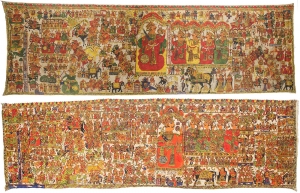
Lot 490 (top) and Lot 491 (bottom). Large Old Indian Narrative Paintings (Pabuji Ki Phad) Early/Mid 20th c.
A notable inclusion in folk art is a pair of lots of large Indian narrative painting, or ‘Pabuji Ki Phad,’ from the early 20th century. This art form, particularly popular in western Rajasthan, chronicles the deeds of the folk deity Pabuji, a Rajput prince. The paintings are created by priest singers called Bhopas, whose songs narrate the scenes depicted. Antique tribal jewelry and ethnographic pieces from the Naga people of northeast India and northwest Myanmar include bright and beautiful necklaces, belts, and headbands made of glass beads, properly documented ivory bracelets and armlets, and a fine cowry shell apron.


